2007 ISUZU KB P190 brake
[x] Cancel search: brakePage 1702 of 6020
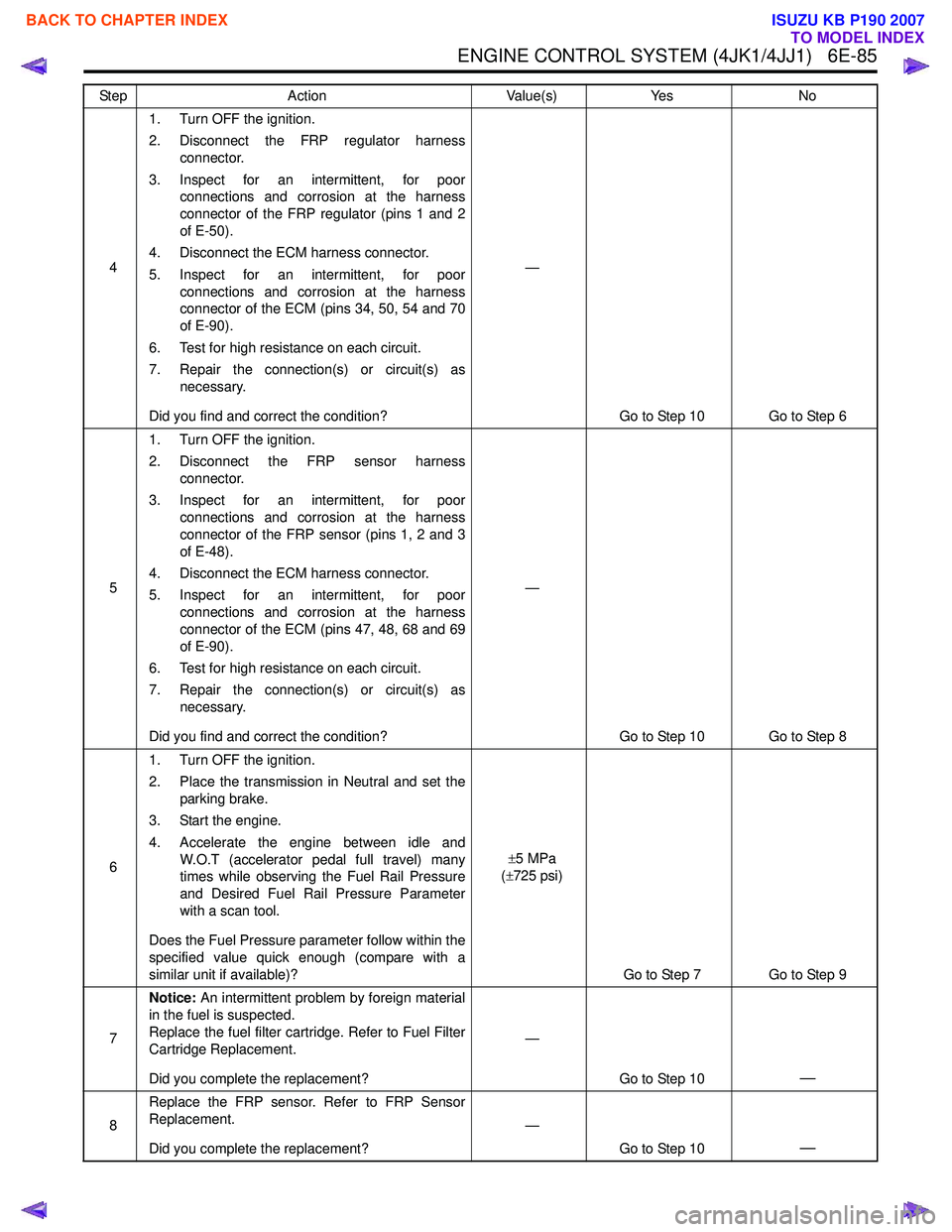
ENGINE CONTROL SYSTEM (4JK1/4JJ1) 6E-85
41. Turn OFF the ignition.
2. Disconnect the FRP regulator harness connector.
3. Inspect for an intermittent, for poor connections and corrosion at the harness
connector of the FRP regulator (pins 1 and 2
of E-50).
4. Disconnect the ECM harness connector.
5. Inspect for an intermittent, for poor connections and corrosion at the harness
connector of the ECM (pins 34, 50, 54 and 70
of E-90).
6. Test for high resistance on each circuit.
7. Repair the connection(s) or circuit(s) as necessary.
Did you find and correct the condition? —
Go to Step 10 Go to Step 6
5 1. Turn OFF the ignition.
2. Disconnect the FRP sensor harness connector.
3. Inspect for an intermittent, for poor connections and corrosion at the harness
connector of the FRP sensor (pins 1, 2 and 3
of E-48).
4. Disconnect the ECM harness connector.
5. Inspect for an intermittent, for poor connections and corrosion at the harness
connector of the ECM (pins 47, 48, 68 and 69
of E-90).
6. Test for high resistance on each circuit.
7. Repair the connection(s) or circuit(s) as necessary.
Did you find and correct the condition? —
Go to Step 10 Go to Step 8
6 1. Turn OFF the ignition.
2. Place the transmission in Neutral and set the parking brake.
3. Start the engine.
4. Accelerate the engine between idle and W.O.T (accelerator pedal full travel) many
times while observing the Fuel Rail Pressure
and Desired Fuel Rail Pressure Parameter
with a scan tool.
Does the Fuel Pressure parameter follow within the
specified value quick enough (compare with a
similar unit if available)? ±
5 MPa
( ± 725 psi)
Go to Step 7 Go to Step 9
7 Notice:
An intermittent problem by foreign material
in the fuel is suspected.
Replace the fuel filter cartridge. Refer to Fuel Filter
Cartridge Replacement.
Did you complete the replacement? —
Go to Step 10
—
8Replace the FRP sensor. Refer to FRP Sensor
Replacement.
Did you complete the replacement? —
Go to Step 10
—
Step Action Value(s)Yes No
BACK TO CHAPTER INDEX
TO MODEL INDEX
ISUZU KB P190 2007
Page 1709 of 6020
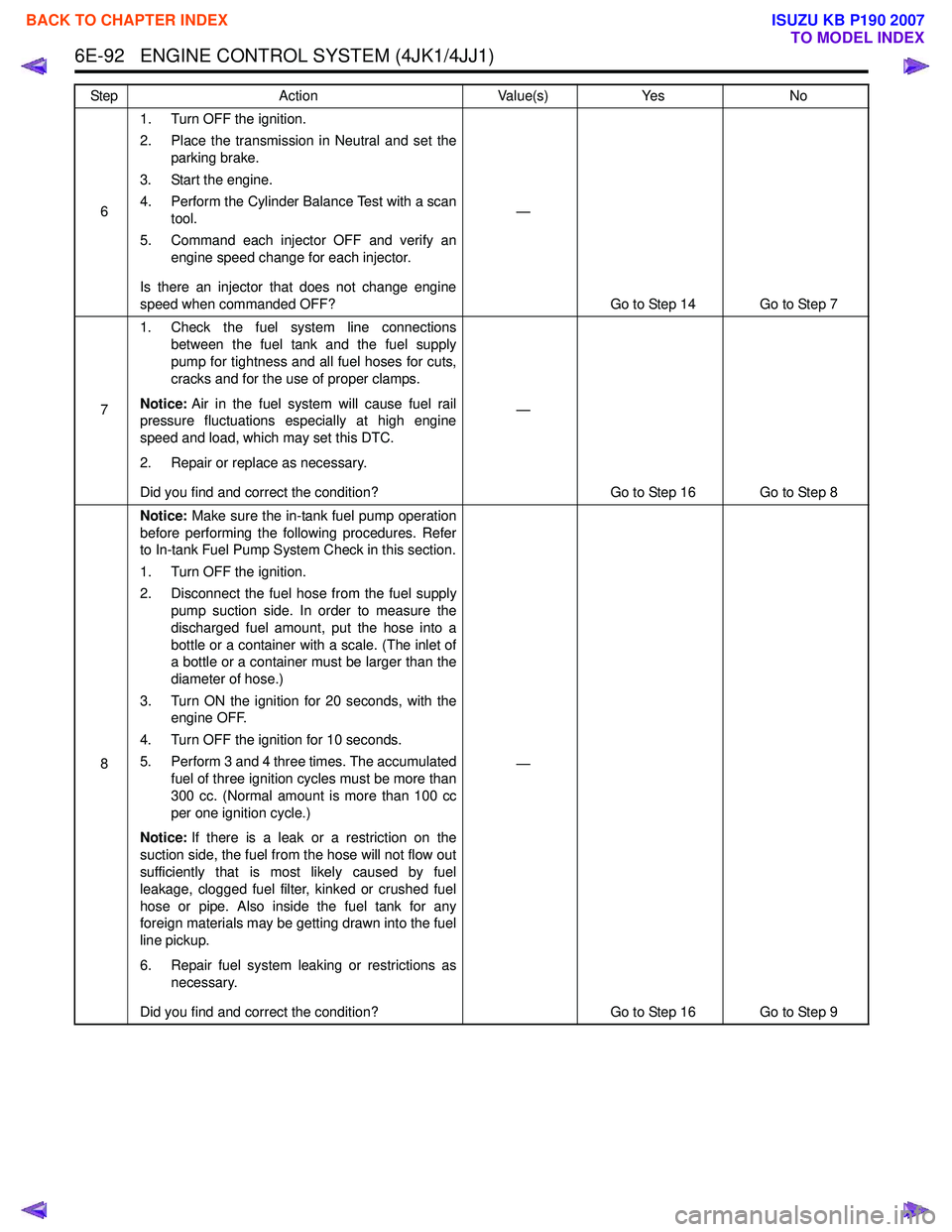
6E-92 ENGINE CONTROL SYSTEM (4JK1/4JJ1)
61. Turn OFF the ignition.
2. Place the transmission in Neutral and set the parking brake.
3. Start the engine.
4. Perform the Cylinder Balance Test with a scan tool.
5. Command each injector OFF and verify an engine speed change for each injector.
Is there an injector that does not change engine
speed when commanded OFF? —
Go to Step 14 Go to Step 7
7 1. Check the fuel system line connections
between the fuel tank and the fuel supply
pump for tightness and all fuel hoses for cuts,
cracks and for the use of proper clamps.
Notice: Air in the fuel system will cause fuel rail
pressure fluctuations especially at high engine
speed and load, which may set this DTC.
2. Repair or replace as necessary.
Did you find and correct the condition? —
Go to Step 16 Go to Step 8
8 Notice:
Make sure the in-tank fuel pump operation
before performing the following procedures. Refer
to In-tank Fuel Pump System Check in this section.
1. Turn OFF the ignition.
2. Disconnect the fuel hose from the fuel supply pump suction side. In order to measure the
discharged fuel amount, put the hose into a
bottle or a container with a scale. (The inlet of
a bottle or a container must be larger than the
diameter of hose.)
3. Turn ON the ignition for 20 seconds, with the engine OFF.
4. Turn OFF the ignition for 10 seconds.
5. Perform 3 and 4 three times. The accumulated fuel of three ignition cycles must be more than
300 cc. (Normal amount is more than 100 cc
per one ignition cycle.)
Notice: If there is a leak or a restriction on the
suction side, the fuel from the hose will not flow out
sufficiently that is most likely caused by fuel
leakage, clogged fuel filter, kinked or crushed fuel
hose or pipe. Also inside the fuel tank for any
foreign materials may be getting drawn into the fuel
line pickup.
6. Repair fuel system leaking or restrictions as necessary.
Did you find and correct the condition? —
Go to Step 16 Go to Step 9
Step
Action Value(s)Yes No
BACK TO CHAPTER INDEX
TO MODEL INDEX
ISUZU KB P190 2007
Page 1808 of 6020
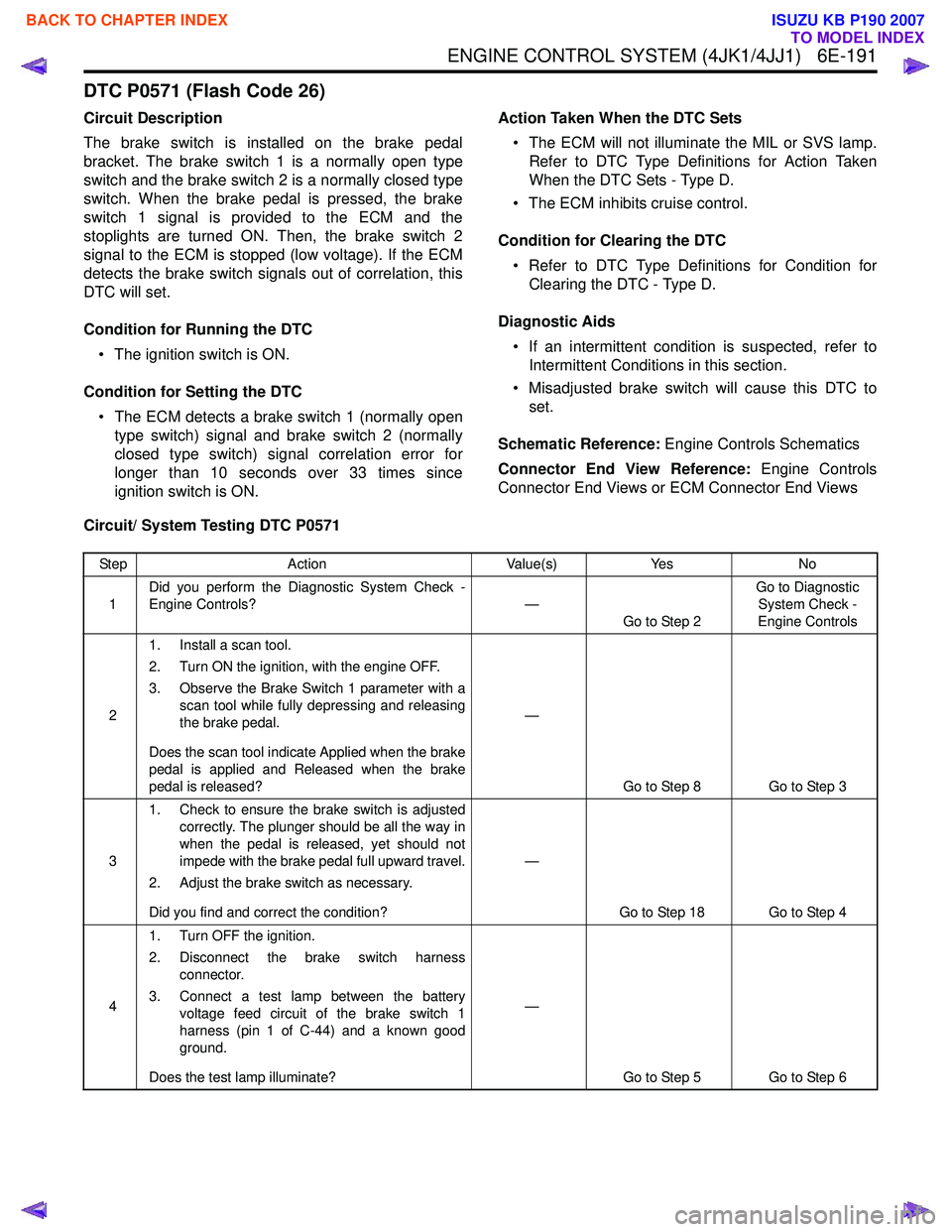
ENGINE CONTROL SYSTEM (4JK1/4JJ1) 6E-191
DTC P0571 (Flash Code 26)
Circuit Description
The brake switch is installed on the brake pedal
bracket. The brake switch 1 is a normally open type
switch and the brake switch 2 is a normally closed type
switch. When the brake pedal is pressed, the brake
switch 1 signal is provided to the ECM and the
stoplights are turned ON. Then, the brake switch 2
signal to the ECM is stopped (low voltage). If the ECM
detects the brake switch signals out of correlation, this
DTC will set.
Condition for Running the DTC • The ignition switch is ON.
Condition for Setting the DTC • The ECM detects a brake switch 1 (normally open type switch) signal and brake switch 2 (normally
closed type switch) signal correlation error for
longer than 10 seconds over 33 times since
ignition switch is ON. Action Taken When the DTC Sets
• The ECM will not illuminate the MIL or SVS lamp. Refer to DTC Type Definitions for Action Taken
When the DTC Sets - Type D.
• The ECM inhibits cruise control.
Condition for Clearing the DTC • Refer to DTC Type Definitions for Condition for Clearing the DTC - Type D.
Diagnostic Aids • If an intermittent condition is suspected, refer to Intermittent Conditions in this section.
• Misadjusted brake switch will cause this DTC to set.
Schematic Reference: Engine Controls Schematics
Connector End View Reference: Engine Controls
Connector End Views or ECM Connector End Views
Circuit/ System Testing DTC P0571
Step Action Value(s)Yes No
1 Did you perform the Diagnostic System Check -
Engine Controls? —
Go to Step 2 Go to Diagnostic
System Check -
Engine Controls
2 1. Install a scan tool.
2. Turn ON the ignition, with the engine OFF.
3. Observe the Brake Switch 1 parameter with a scan tool while fully depressing and releasing
the brake pedal.
Does the scan tool indicate Applied when the brake
pedal is applied and Released when the brake
pedal is released? —
Go to Step 8 Go to Step 3
3 1. Check to ensure the brake switch is adjusted
correctly. The plunger should be all the way in
when the pedal is released, yet should not
impede with the brake pedal full upward travel.
2. Adjust the brake switch as necessary.
Did you find and correct the condition? —
Go to Step 18 Go to Step 4
4 1. Turn OFF the ignition.
2. Disconnect the brake switch harness connector.
3. Connect a test lamp between the battery voltage feed circuit of the brake switch 1
harness (pin 1 of C-44) and a known good
ground.
Does the test lamp illuminate? —
Go to Step 5 Go to Step 6
BACK TO CHAPTER INDEX
TO MODEL INDEX
ISUZU KB P190 2007
Page 1809 of 6020
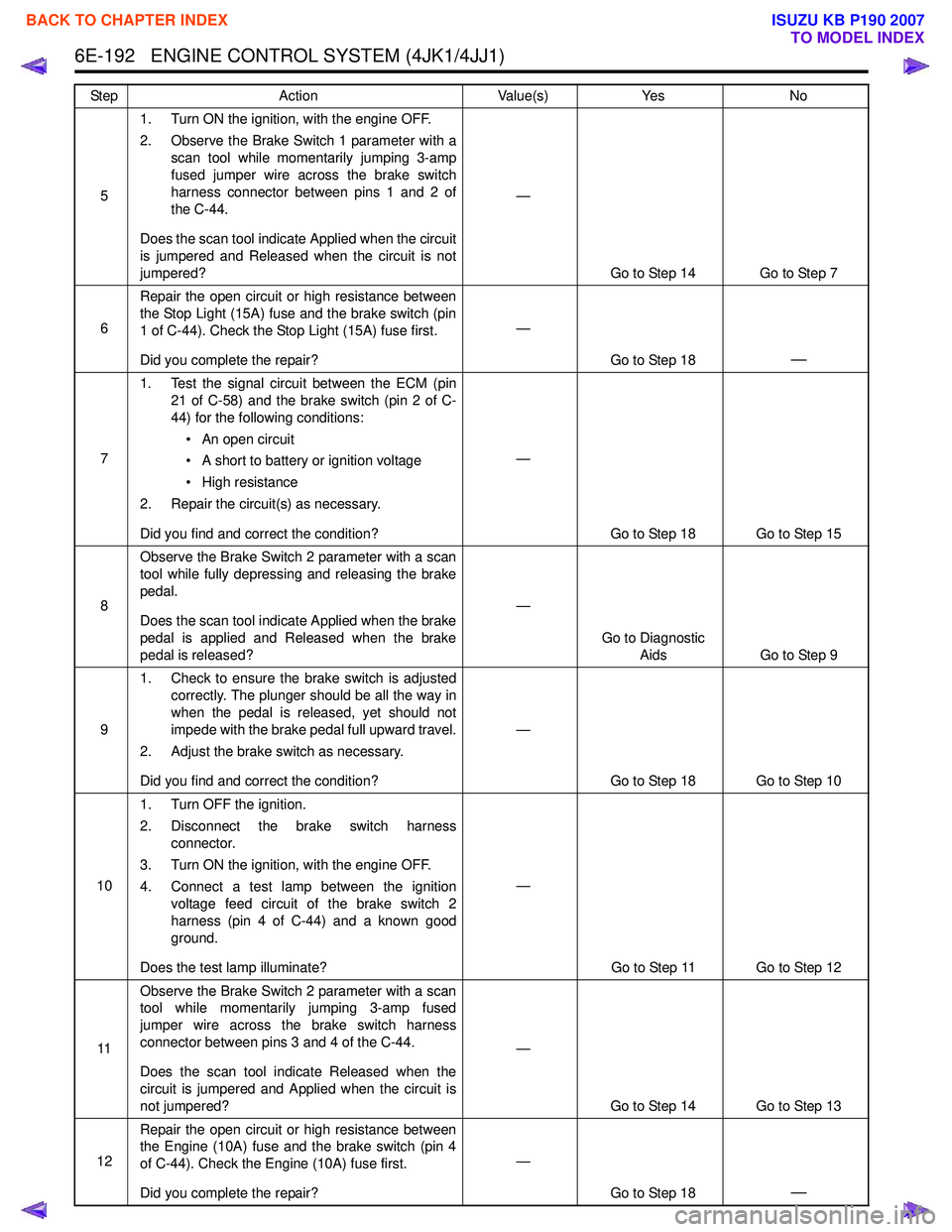
6E-192 ENGINE CONTROL SYSTEM (4JK1/4JJ1)
51. Turn ON the ignition, with the engine OFF.
2. Observe the Brake Switch 1 parameter with a scan tool while momentarily jumping 3-amp
fused jumper wire across the brake switch
harness connector between pins 1 and 2 of
the C-44.
Does the scan tool indicate Applied when the circuit
is jumpered and Released when the circuit is not
jumpered? —
Go to Step 14 Go to Step 7
6 Repair the open circuit or high resistance between
the Stop Light (15A) fuse and the brake switch (pin
1 of C-44). Check the Stop Light (15A) fuse first.
Did you complete the repair? —
Go to Step 18
—
71. Test the signal circuit between the ECM (pin
21 of C-58) and the brake switch (pin 2 of C-
44) for the following conditions:
• An open circuit
• A short to battery or ignition voltage
• High resistance
2. Repair the circuit(s) as necessary.
Did you find and correct the condition? —
Go to Step 18 Go to Step 15
8 Observe the Brake Switch 2 parameter with a scan
tool while fully depressing and releasing the brake
pedal.
Does the scan tool indicate Applied when the brake
pedal is applied and Released when the brake
pedal is released? —
Go to Diagnostic Aids Go to Step 9
9 1. Check to ensure the brake switch is adjusted
correctly. The plunger should be all the way in
when the pedal is released, yet should not
impede with the brake pedal full upward travel.
2. Adjust the brake switch as necessary.
Did you find and correct the condition? —
Go to Step 18 Go to Step 10
10 1. Turn OFF the ignition.
2. Disconnect the brake switch harness connector.
3. Turn ON the ignition, with the engine OFF.
4. Connect a test lamp between the ignition voltage feed circuit of the brake switch 2
harness (pin 4 of C-44) and a known good
ground.
Does the test lamp illuminate? —
Go to Step 11 Go to Step 12
11 Observe the Brake Switch 2 parameter with a scan
tool while momentarily jumping 3-amp fused
jumper wire across the brake switch harness
connector between pins 3 and 4 of the C-44.
Does the scan tool indicate Released when the
circuit is jumpered and Applied when the circuit is
not jumpered? —
Go to Step 14 Go to Step 13
12 Repair the open circuit or high resistance between
the Engine (10A) fuse and the brake switch (pin 4
of C-44). Check the Engine (10A) fuse first.
Did you complete the repair? —
Go to Step 18
—
Step Action Value(s)Yes No
BACK TO CHAPTER INDEX
TO MODEL INDEX
ISUZU KB P190 2007
Page 1810 of 6020

ENGINE CONTROL SYSTEM (4JK1/4JJ1) 6E-193
131. Test the signal circuit between the ECM (pin 1
of C-58) and the brake switch (pin 3 of C-44)
for the following conditions:
• An open circuit
• A short to battery or ignition voltage
• High resistance
2. Repair the circuit(s) as necessary.
Did you find and correct the condition? —
Go to Step 18 Go to Step 15
14 1. Inspect for an intermittent and for poor
connections at the harness connector of the
brake switch (pins 1, 2, 3 and 4 of C-44).
2. Repair the connection(s) as necessary.
Did you find and correct the condition? —
Go to Step 18 Go to Step 16
15 1. Turn OFF the ignition.
2. Disconnect the ECM harness connector.
3. Inspect for an intermittent and for poor connections at the harness connector of the
ECM (pins 1 and 21 of C-58).
4. Repair the connection(s) as necessary.
Did you find and correct the condition? —
Go to Step 18 Go to Step 17
16 Replace brake switch. Refer to Brake Switch
Replacement.
Did you complete the replacement? —
Go to Step 18
—
17Important:
Replacement ECM must be
programmed and learned.
Replace the ECM. Refer to ECM Replacement.
Did you complete the replacement? —
Go to Step 18
—
181. Reconnect all previously disconnected fuse or
harness connector(s).
2. Clear the DTCs with a scan tool.
3. Turn OFF the ignition for 30 seconds.
4. Turn ON the ignition, with the engine OFF.
5. Observe the Brake Switch 1 and Brake Switch 2 parameter with a scan tool while fully
depressing and releasing the brake pedal.
Does the scan tool indicate Applied when the brake
pedal is applied and Released when the brake
pedal is released on each parameter? —
Go to Step 19 Go to Step 2
19 Observe the DTC Information with a scan tool.
Are there any DTCs that you have not diagnosed? —
Go to DTC List System OK
Step
Action Value(s)Yes No
BACK TO CHAPTER INDEX
TO MODEL INDEX
ISUZU KB P190 2007
Page 1844 of 6020
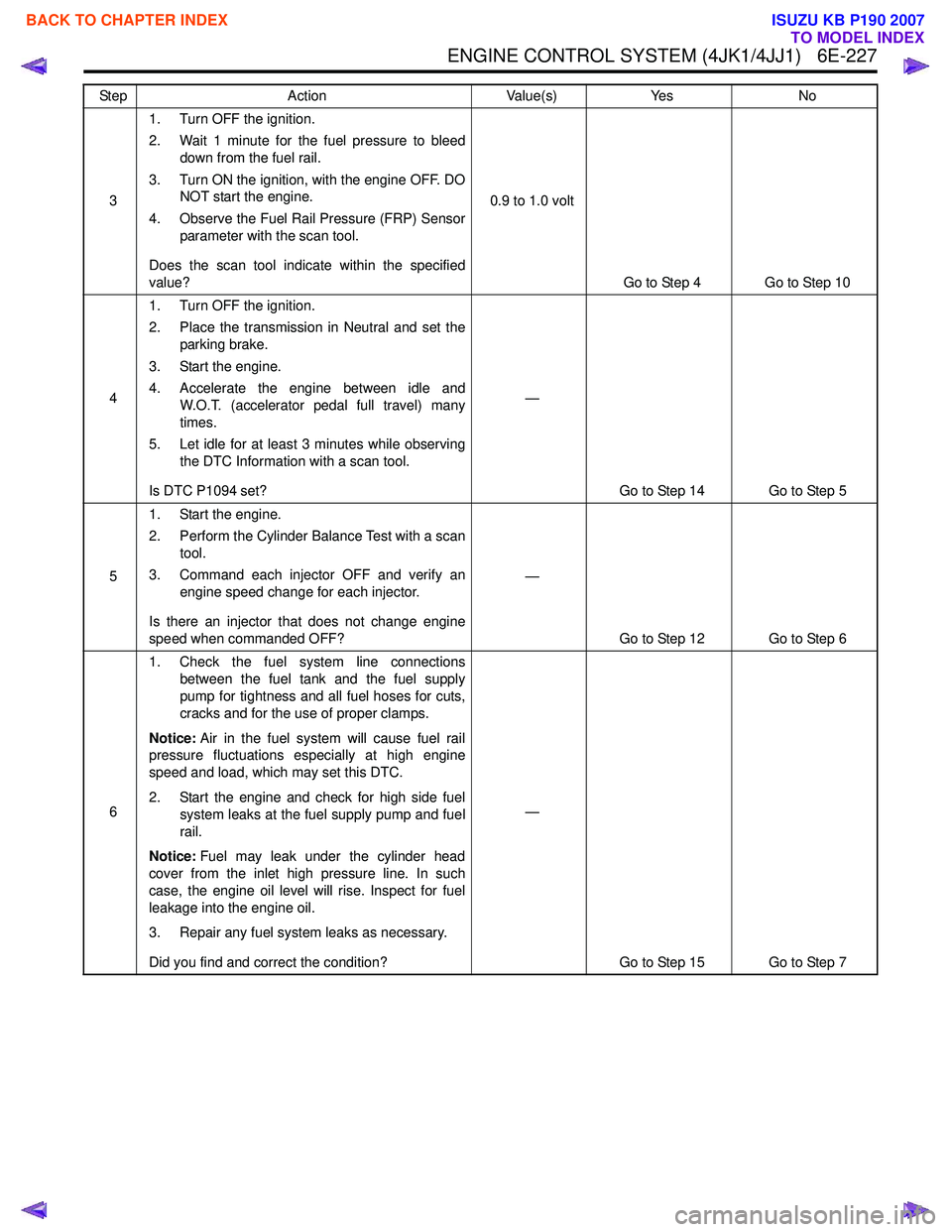
ENGINE CONTROL SYSTEM (4JK1/4JJ1) 6E-227
31. Turn OFF the ignition.
2. Wait 1 minute for the fuel pressure to bleed down from the fuel rail.
3. Turn ON the ignition, with the engine OFF. DO NOT start the engine.
4. Observe the Fuel Rail Pressure (FRP) Sensor parameter with the scan tool.
Does the scan tool indicate within the specified
value? 0.9 to 1.0 volt
Go to Step 4 Go to Step 10
4 1. Turn OFF the ignition.
2. Place the transmission in Neutral and set the parking brake.
3. Start the engine.
4. Accelerate the engine between idle and W.O.T. (accelerator pedal full travel) many
times.
5. Let idle for at least 3 minutes while observing the DTC Information with a scan tool.
Is DTC P1094 set? —
Go to Step 14 Go to Step 5
5 1. Start the engine.
2. Perform the Cylinder Balance Test with a scan tool.
3. Command each injector OFF and verify an engine speed change for each injector.
Is there an injector that does not change engine
speed when commanded OFF? —
Go to Step 12 Go to Step 6
6 1. Check the fuel system line connections
between the fuel tank and the fuel supply
pump for tightness and all fuel hoses for cuts,
cracks and for the use of proper clamps.
Notice: Air in the fuel system will cause fuel rail
pressure fluctuations especially at high engine
speed and load, which may set this DTC.
2. Start the engine and check for high side fuel system leaks at the fuel supply pump and fuel
rail.
Notice: Fuel may leak under the cylinder head
cover from the inlet high pressure line. In such
case, the engine oil level will rise. Inspect for fuel
leakage into the engine oil.
3. Repair any fuel system leaks as necessary.
Did you find and correct the condition? —
Go to Step 15 Go to Step 7
Step
Action Value(s)Yes No
BACK TO CHAPTER INDEX
TO MODEL INDEX
ISUZU KB P190 2007
Page 1850 of 6020

ENGINE CONTROL SYSTEM (4JK1/4JJ1) 6E-233
51. Turn OFF the ignition.
2. Wait 1 minute for the fuel pressure to bleed down from the fuel rail.
3. Turn ON the ignition, with the engine OFF. DO NOT start the engine.
4. Observe the Fuel Rail Pressure (FRP) Sensor parameter with the scan tool.
Does the scan tool indicate within the specified
value? 0.9 to 1.0 volt
Go to Step 6 Go to Step 13
6 1. Turn OFF the ignition.
2. Place the transmission in Neutral and set the parking brake.
3. Start the engine and let idle for at least 3 minutes while observing the DTC Information
with a scan tool.
Does the DTC fail this ignition? —
Go to Step 8 Go to Step 7
7 1. Accelerate the engine between idle and
W.O.T. (accelerator pedal full travel) many
times.
2. Let idle for at least 3 minutes while observing the DTC Information with a scan tool.
Does the DTC fail this ignition? —
Go to Step 18 Go to Step 8
8 1. Start the engine.
2. Perform the Cylinder Balance Test with a scan tool.
3. Command each injector OFF and verify an engine speed change for each injector.
Is there an injector that does not change engine
speed when commanded OFF? —
Go to Step 16 Go to Step 9
9 1. Check the fuel system line connections
between the fuel tank and the fuel supply
pump for tightness and all fuel hoses for cuts,
cracks and for the use of proper clamps.
Notice: Air in the fuel system will cause fuel rail
pressure fluctuations especially at high engine
speed and load, which may set this DTC.
2. Repair or replace as necessary.
Did you find and correct the condition? —
Go to Step 19 Go to Step 10
Step
Action Value(s)Yes No
BACK TO CHAPTER INDEX
TO MODEL INDEX
ISUZU KB P190 2007
Page 1920 of 6020
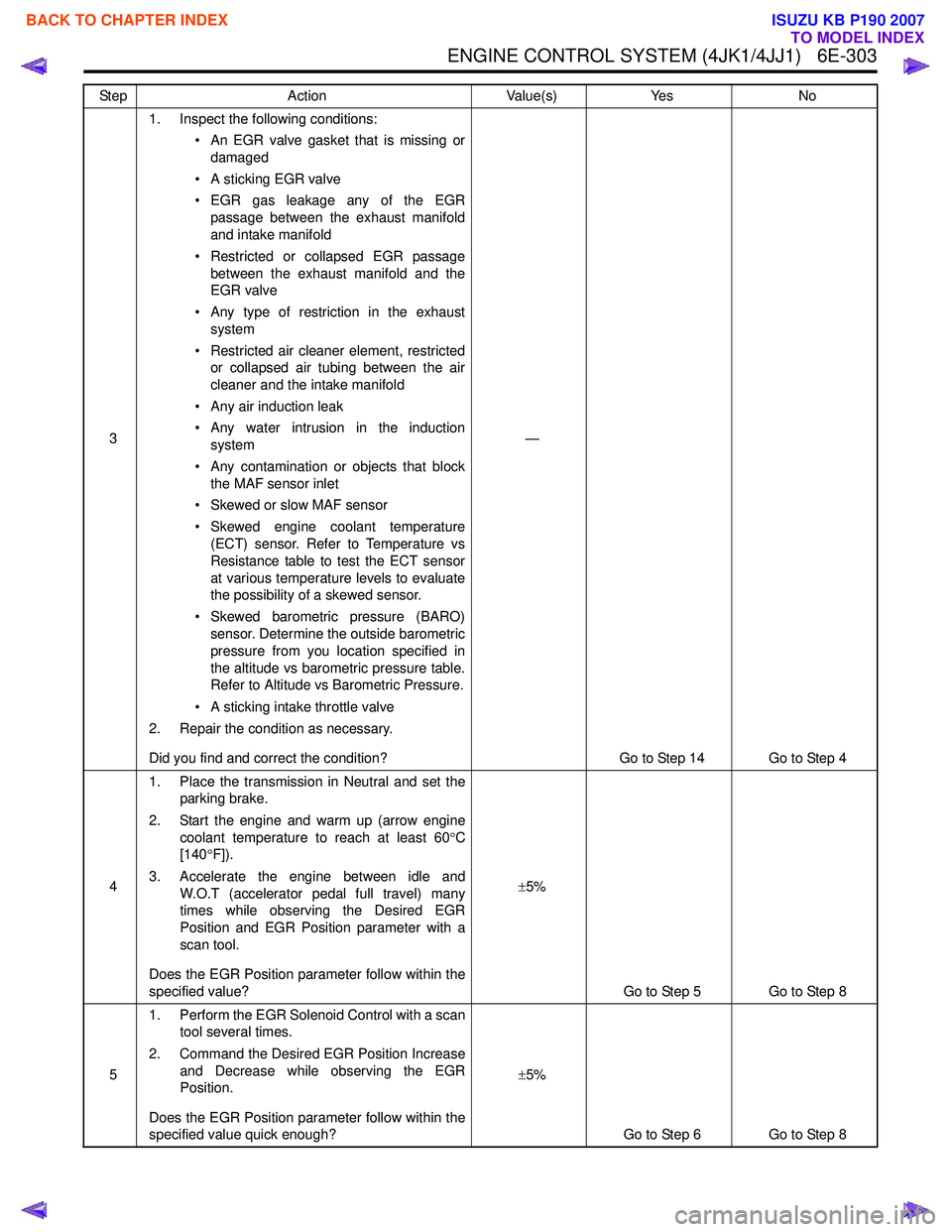
ENGINE CONTROL SYSTEM (4JK1/4JJ1) 6E-303
31. Inspect the following conditions:
• An EGR valve gasket that is missing ordamaged
• A sticking EGR valve
• EGR gas leakage any of the EGR passage between the exhaust manifold
and intake manifold
• Restricted or collapsed EGR passage between the exhaust manifold and the
EGR valve
• Any type of restriction in the exhaust system
• Restricted air cleaner element, restricted or collapsed air tubing between the air
cleaner and the intake manifold
• Any air induction leak
• Any water intrusion in the induction system
• Any contamination or objects that block the MAF sensor inlet
• Skewed or slow MAF sensor
• Skewed engine coolant temperature (ECT) sensor. Refer to Temperature vs
Resistance table to test the ECT sensor
at various temperature levels to evaluate
the possibility of a skewed sensor.
• Skewed barometric pressure (BARO) sensor. Determine the outside barometric
pressure from you location specified in
the altitude vs barometric pressure table.
Refer to Altitude vs Barometric Pressure.
• A sticking intake throttle valve
2. Repair the condition as necessary.
Did you find and correct the condition? —
Go to Step 14 Go to Step 4
4 1. Place the transmission in Neutral and set the
parking brake.
2. Start the engine and warm up (arrow engine coolant temperature to reach at least 60 °C
[140 °F]).
3. Accelerate the engine between idle and W.O.T (accelerator pedal full travel) many
times while observing the Desired EGR
Position and EGR Position parameter with a
scan tool.
Does the EGR Position parameter follow within the
specified value? ±
5%
Go to Step 5 Go to Step 8
5 1. Perform the EGR Solenoid Control with a scan
tool several times.
2. Command the Desired EGR Position Increase and Decrease while observing the EGR
Position.
Does the EGR Position parameter follow within the
specified value quick enough? ±
5%
Go to Step 6 Go to Step 8
Step
Action Value(s)Yes No
BACK TO CHAPTER INDEX
TO MODEL INDEX
ISUZU KB P190 2007